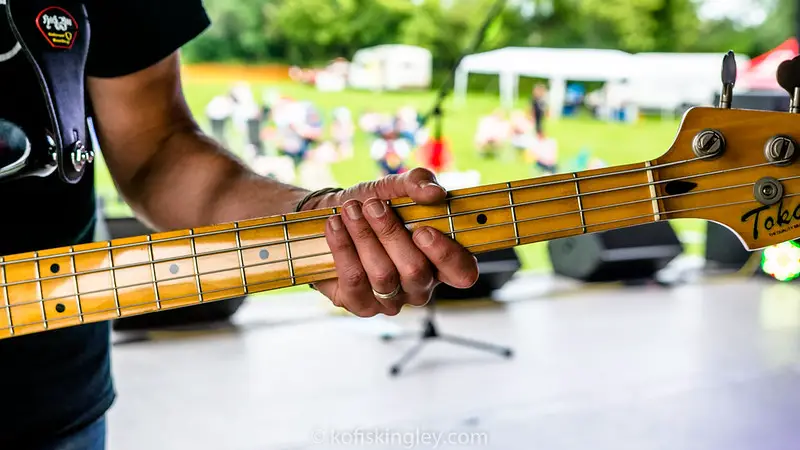Bassists are often on an unending quest for their ideal tone, and often refer to tone punch. What constitutes a punchy bass tone?
The right amount of volume, attack, definition (clarity) and the ability to cut through the mix are the main characteristics of a punchy bass tone. A good bass tone is well balanced and can sit in the mix without overshadowing other instruments or getting drowned out by their sound.
A punchy bass tone will sit well in a mix and cut through it with just the right amount of aggression. We are talking about a big and full bass thump that hits you in the chest and can hold its ground against the rest of the band. No woof. No mud. No boom.
Aesthetically, tone can be a subjective topic, but the science of it isn’t. There are many ways to achieve a fat, beefy or punchy bass tone and I will walk you through some important concepts with practical examples of how to achieve this.
Table of Contents
How to achieve a punchy bass tone
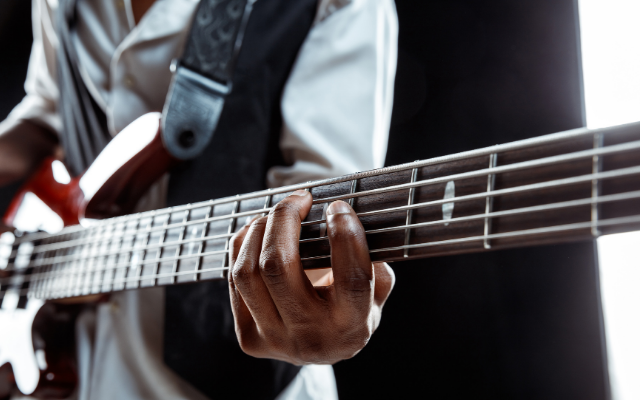
We all have drooled over the ‘punch’ of Flea’s bass playing in Red Hot Chili Peppers and the thump/growl of Steve Harris, Geddy Lee, Robert Trujillo and countless others.
In our own way, we all strive to figure out the dos and don’ts that will achieve that elusive ‘oomph’ that can elevate our playing.
This quest is challenging because the human ear is a lot better at distinguishing between higher frequencies than it is at processing low end.
Getting a punchy tone requires an ideal combination of bass, amp head and cabinet and a good knowledge of how to use the EQ settings.
Plucking hand technique, pickup configuration, guitar brand and model, amplifier or speaker cabinet, EQ, compression, signal chain and output speakers (PA system) all play a role in shaping the clarity, punch and definition of the final sound that your audience hears.
Punch is also a function of how your sound interacts with all the other instruments in the band, also competing for space in the mix. Here are a few examples of elements that will help you obtain a punchy tone:
- Use a Precision style or other good bolt-on bass
- Use bright sounding roundwound strings
- Use a high-mass bridge like Badass II for added oomph
- Turn the Bridge Pickup knob up to full capacity (10)
- Roll down the Neck Pickup to about halfway (3-6)
- Dig in with your right (plucking hand)
- Play between the pickup and the bridge
- Use moderate compression with a stronger attack than release
See also: Choosing The Best Bass Amp For Funk
Plucking hand technique
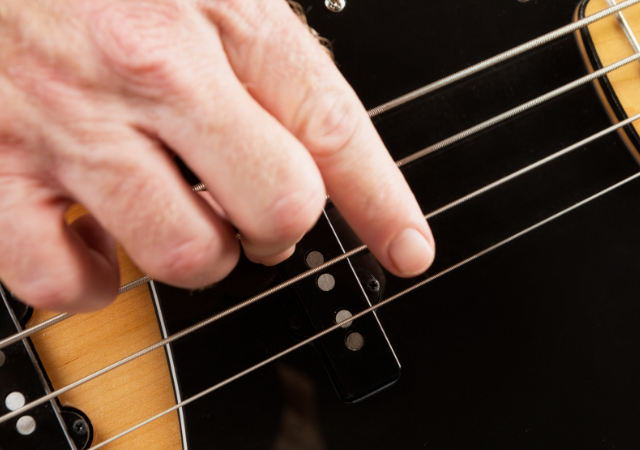
Your plucking hand technique is also a serious and often overlooked factor in achieving a punchy bass tone. Tone is heavily influenced by the strength and intensity of your fingers.
Dig in: your plucking hand should play as hard as possible without compromising technique. Hand/finger placement should generally be between the pickup and bridge.
This doesn’t mean you constantly play by the bridge in every song; this is just one style that works when you want to cut through with more high-end definition.
The downside to playing with high intensity by the bridge is that it demands a lot of finger strength and stamina to sustain this for longer periods.
Some bassists like Geddy Lee (Rush) and Duff McKagan (Guns ‘n’ Roses) prefer to playi above the neck pickup with a heavy attack to get an aggressive and highly revered ‘clangy’ tone.
Pro-Tip: Though most bassists use their fingers, using a pick can enhance the attack and add to your tone’s punchiness.
See also: How hard should I pluck bass strings?
Pickups
The magnet/coil structure and circuit topology of the pickups also affect how punchy a bass tone can be. On most basses, you can get a punchier tone by rolling off the neck pickup and playing closer to the bridge
Dynamics
Genres like reggae and funk make use of a lot of staccato playing which adds ghost notes and rhythmic/percussive motifs to your bass line and can help make your sound punchier.
Staccato playing can be achieved by left and right-hand technique, including through the use of palm muting with your plucking hand. This helps in controlling the dynamics of your sound.
See also: How To Dial In A Great Dub Sound
Choice of bass & amp for a punchy tone
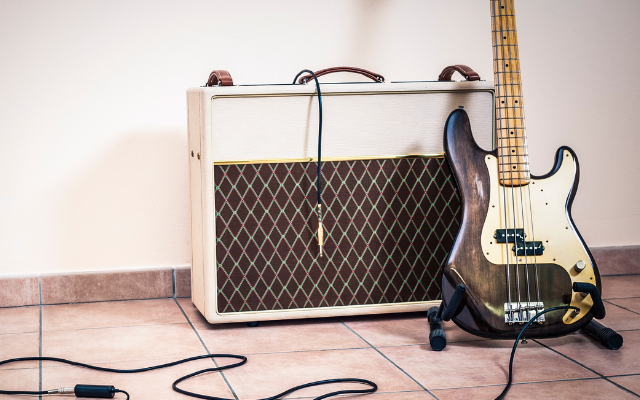
The guitar (including the hardware and electronics) is the ‘source sound’ and the wisest words you will ever hear is ‘Get it right at the source’.
A Fender Precision Bass strung with RS66 round wounds going through an Ampeg SVT Pro with an 8 x 10 cab will typically produce a good punchy tone.
The Fender Precision Bass has a reputation for delivering rich low-mids without making the overall tone too woofy.
If you own a P-style bass, slap on some flatwounds and use some foam under the bridge to mute/dampen the sustain (like giving punches through your amp).
On an active bass, you can boost the mids. A J-bass style bridge and Musicman style pickups can provide more punch. P-bass pickups can also deliver a punchy tone if you play near the bridge.
With regards to amps, a good head (e.g. Markbass) and cabinet will help give your sound the desired punch. An Amped SVT (with an active bass) or a classic Gallien Krueger 400RB, 700RB, or 800RB with contour off and good speakers will help a lot.
Pro-Tip: Instead of buying a new amplifier you can replace the speaker (drive) and save a lot of money. Celestion, Jensen and Eminence make good bass amp replacement speakers.
Bass amps usually use 10, 12 or 15 inch speakers. The smaller ones have more clarity while the large ones have more power handling but can sound boomy.
Choice of strings
The string material, winding, tension, compliance and distance from the pickup play a role in shaping the tone.
Different people have different preferences, but I’ve found that rounds seem to get me more punch than flats.
Among rounds, steel and nickel strings have a reputation for sounding bright. Here are a few recommendations to try out for a punchier sound:
- DR Hi-beams (Roundwound)
- Rotosound 66 (Roundwound)
- D’Addario ProSteels (Roundwound)
Amp & Bass EQ settings
A punchy tone rarely uses anything below 100Hz. You should start with a flat EQ and only add what you need.
- Keep the lows at moderate levels. Most bassists love to boost the low end but this can be the exact reason why your bass sounds muddy.
- Pay attention to the low-mids, they are useful in achieving a rounded tone and a strong punch. However, low-mids alone won’t help the tone cut through the mix.
You need to find your ‘sweet spot’ in the 800 – 1600 Hz range (closer to 1k) to add more beef. - The highs/treble add definition and clarity to your overall tone. Go easy, too little will make you sound muffled and too much will make you sound brittle and harsh.
If you are using a bass with active pickups and three-band equalizer – keep the bass at (75%), mids at below half (35-45%) and treble at half (50%). Set the amp master volume at half and use the master knob on your bass to increase or decrease volume.
Once you settle on a sound, fine tune it by identifying boomy frequencies and EQ them out. Keep ‘spare’ headroom in your amp which will come in handy when you dig in and play louder.
Compression for punch
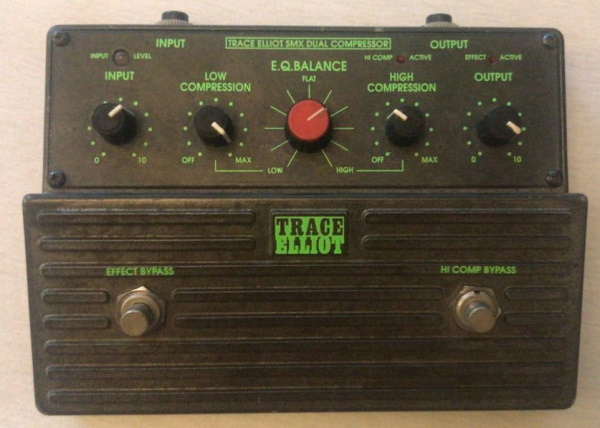
Compression adds fullness and coherence because shaping the wave (note) plays an important role in shaping the sound.
Learn how to manipulate the ADSR envelope – ADSR refers to Attack, Decay, Sustain and Release.
As a basic setting to get started, use a fast attack, slow release, medium threshold (half-way) and a 3:1 ratio. Now tweak to your heart’s content.
Aim for a tone that ‘peaks’ through the compressor (accentuated attack) and then ‘falls off’ for the remaining part. This dynamic variance will make your bass sound punchier.
You can EQ this further by cutting lows to 9 o’clock and boosting the mids and treble (1 o’clock). Now you got a tone that is punchy with a curved out bottom and well-defined highs.
If you use compression moderately, you will get a clean boost. If you overdo it, it will unpleasantly squash your bass tone. Adjust the make-up gain each time you vary/alter the compression to compensate for the loss or gain in volume.
A compressor isn’t meant to be used as an EQing device, but a good unit can be invaluable in shaping your tone.
See also: Best Compressor For 5-String Bass: The Low Range Holy Grail
The art of dialing in a punchy bass tone

Your ability to dial in a punchy bass tone is related to your ability to identify which part of the frequency range is imbalanced to get the best possible tone from any combination of equipment you are using.
This, however, requires practice and patience. Here is a simple way in which you can go about it.
Record a few minutes of your bass-playing with the help of a computer and a DAW (like Cubase, Logic Pro X etc.).
Once you have the audio file, load a spectrum analyzer and a basic 3 band graphic EQ plugin (any stock plugin will do) to tweak the audio.
Put on your headphones and experiment with the plugin knobs and sliders to see how they impact the sound.
The optical spectrum analyzer will provide visual clues that will help you understand the interaction between the sound signal and your modifications, and help you dial in your sound more quickly and accurately.
Once you have the skill to identify the problematic parts of the frequency range, you can proceed to experiment with that same knowledge in your analog gear – the physical knobs in your amplifier and EQ pedals – to improve the tone.
If you still aren’t satisfied with the tone, it may mean that some of your gear needs an upgrade.
Other considerations for a punchy tone
Don’t underestimate the relationship of the bass and the kick drum. They work as a team and compete for the same ‘space/frequency’ in the mix.
A mature bassist and drummer learn to complement each other instead of contradicting each other (see this post for more on bass guitar and drums relationship).
Each song has an aesthetic context and sonic landscape within which a bass player has to play and sound good. A good-sounding tone in metal may not sound good for funk.
The instrumentation and song arrangement are other important in influencing your bass tone. Instruments like the trombone, grand piano, rock organ, synth and clavinet are also competing with the bass guitar in the 60 to 250 Hz frequency range.
Also, when you hear a song like Dean Town by Vulfpeck and try to emulate its sound, be aware that it has been heavily treated in the post-production process with considerable editing, mixing and mastering.
Your gear and venue may not allow for that level of fine-tuning and refinement.
I’ll wrap up with a few songs with punchy bass to inspire you:
- Vulfpeck – Dean Town
- Brian Bromberg – Elephants on Ice Skates
- Marcus Miller – Detroit
- RHCP – Around the World
- Led Zepplin – The Immigrant Song
- Iron Maiden – Caught Somewhere in Time
- Jamiroquai – Love Foolosophy
- Queen – Another One Bites the Dust
***
Photo credits:
Featured image: “KOF_5650” (CC BY 2.0) by kofiskingley

